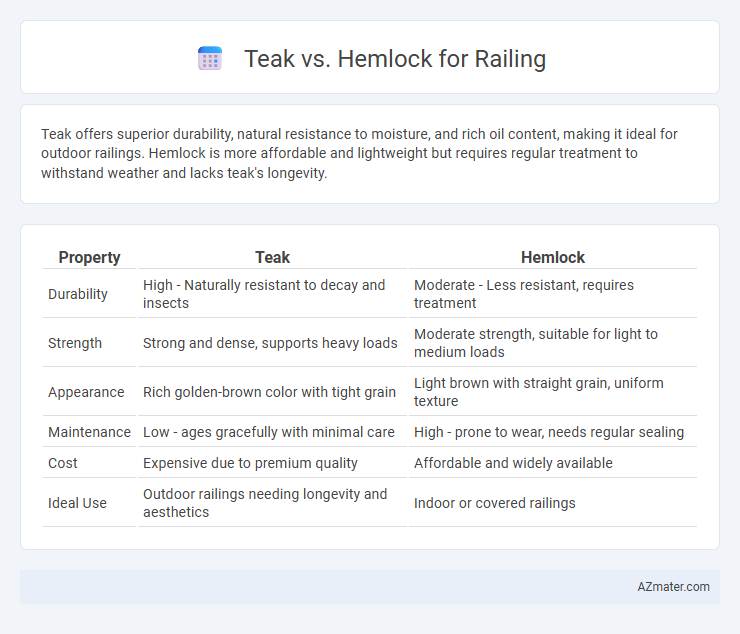Teak offers superior durability, natural resistance to moisture, and rich oil content, making it ideal for outdoor railings. Hemlock is more affordable and lightweight but requires regular treatment to withstand weather and lacks teak's longevity.
Table of Comparison
| Property | Teak | Hemlock |
|---|---|---|
| Durability | High - Naturally resistant to decay and insects | Moderate - Less resistant, requires treatment |
| Strength | Strong and dense, supports heavy loads | Moderate strength, suitable for light to medium loads |
| Appearance | Rich golden-brown color with tight grain | Light brown with straight grain, uniform texture |
| Maintenance | Low - ages gracefully with minimal care | High - prone to wear, needs regular sealing |
| Cost | Expensive due to premium quality | Affordable and widely available |
| Ideal Use | Outdoor railings needing longevity and aesthetics | Indoor or covered railings |
Introduction to Teak and Hemlock Railings
Teak and hemlock are two popular wood choices for railing systems, each offering distinct qualities that impact durability and aesthetic appeal. Teak is renowned for its high oil content and dense grain, providing exceptional resistance to moisture, decay, and insects, making it ideal for outdoor railings in harsh weather conditions. Hemlock, a softer and more affordable softwood, offers a straight-grain texture and is often treated for enhanced weather resistance, serving well in budget-conscious projects with moderate exposure.
Key Differences Between Teak and Hemlock
Teak offers superior durability and natural resistance to moisture, decay, and insects, making it ideal for outdoor railings exposed to harsh weather. Hemlock, while more affordable and easier to work with, lacks the same level of rot resistance and requires regular maintenance to prevent deterioration. The warm golden-brown hue of teak contrasts with the pale, light color of hemlock, influencing the aesthetic appeal and finish longevity of railing projects.
Durability and Longevity Comparison
Teak offers exceptional durability and longevity for railings due to its dense natural oils that resist moisture, rot, and insect damage, making it ideal for outdoor use in harsh weather conditions. Hemlock, while more affordable, lacks the natural oils of teak and is more prone to wear, decay, and insect infestation, resulting in a shorter lifespan. Investing in teak railings ensures a long-lasting, low-maintenance solution with superior resistance to environmental stressors compared to hemlock.
Resistance to Weather and Decay
Teak wood offers superior resistance to weather and decay due to its high oil content and natural tannins, making it ideal for outdoor railings exposed to moisture and sunlight. Hemlock is less durable in harsh weather conditions, requiring regular treatment to prevent rot and insect damage. Choosing teak for railing ensures long-lasting performance with minimal maintenance in varying climates.
Maintenance and Care Requirements
Teak railing offers superior durability and requires minimal maintenance due to its natural oils that resist moisture, pests, and rot, needing only periodic cleaning and occasional oiling to maintain its golden hue. Hemlock railings demand more frequent upkeep, including regular sealing or staining to protect against weathering, moisture damage, and insect infestation, as its softer wood is more prone to cracking and decay over time. Choosing teak reduces long-term maintenance efforts and costs, while hemlock requires consistent care to preserve structural integrity and aesthetic appeal.
Aesthetic Appeal and Design Versatility
Teak offers a rich, warm golden-brown hue with natural oils that enhance its smooth texture and resistance to weather, making it ideal for elegant, timeless railing designs. Hemlock features a lighter, pale color with a fine, even grain that lends itself to sleek, modern aesthetics and can be easily stained or painted for customizable finishes. The design versatility of teak suits both traditional and contemporary settings, while hemlock's adaptability supports a broader range of styles from rustic to minimalist.
Cost Analysis: Teak vs Hemlock
Teak wood generally commands a higher price due to its durability, natural oils, and resistance to weathering, making it a premium choice for railings with a longer lifespan. Hemlock, being more affordable and widely available, offers a cost-effective alternative but may require more frequent maintenance and treatment to withstand outdoor conditions. Evaluating initial purchase price against long-term maintenance costs is crucial when choosing between teak and hemlock for railing projects.
Environmental Impact and Sustainability
Teak is a tropical hardwood known for its durability and natural resistance to decay, often sourced from plantations, yet concerns remain about deforestation in uncontrolled harvesting regions. Hemlock is a softwood commonly harvested from sustainably managed forests in North America, making it a more environmentally friendly option due to faster growth rates and lower ecological footprint. Choosing hemlock for railing supports sustainable forestry practices and reduces the risk of contributing to habitat loss compared to teak's variable sourcing methods.
Installation Considerations
Teak offers excellent durability and natural oils that resist rot and insects, reducing maintenance during railing installation, but its higher density requires pre-drilling and specialized fasteners to prevent splitting. Hemlock, being softer and more lightweight, is easier to cut and install with standard tools and fasteners but demands careful sealing and regular maintenance to protect against moisture and decay. Proper assessment of these material properties ensures a secure, long-lasting railing installation tailored to environmental exposure.
Final Verdict: Choosing the Best Wood for Railings
Teak offers exceptional durability, natural resistance to moisture, and rich grain patterns, making it ideal for long-lasting, low-maintenance railings in outdoor environments. Hemlock, while more affordable and easier to work with, lacks the inherent weather resistance and tends to require more frequent sealing or treatment to prevent decay. For premium, sturdy railings that withstand varying weather conditions with minimal upkeep, teak remains the superior choice.

Infographic: Teak vs Hemlock for Railing
 azmater.com
azmater.com